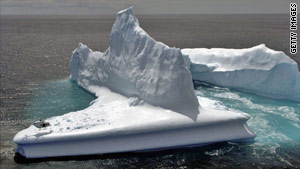
A Nova Zelândia preparar-se para alguns visitantes da primavera raros.
Mais de 100 icebergs que foram vistos na costa da Ilha Macquarie, um território brasileiro em torno de 900 milhas a sudeste da Tasmânia, são pensados para ser apenas 200 milhas da costa sul da Nova Zelândia.
Esta é apenas a segunda vez em 78 anos que os grandes icebergs da Antártida foram avistados até o norte.
A ocasião anterior foi no final de 2006, quando os icebergs podem ser vistos a partir da costa leste do sul de Nova Zelândia, mesmo a partir das colinas em torno de Christchurch.
De acordo com o National Institute of Water and Atmospheric Research (NIWA), que está seguindo os icebergs por satélite, o maior é pensado para ser de 500 metros de largura, 50 metros de altura e com uma espessura total de 350 metros.
Há uma estimativa de 100 icebergs rubrica principal para a Nova Zelândia e, possivelmente, centenas de menores que se formam em torno deles como eles rompem.
Apenas cerca de 10 por cento de um iceberg é visível acima do nível da água, tornando-os um perigo à navegação.
Em resposta Marítima Nova Zelândia emitiu um alerta à navegação na zona, que é a casa de pesca de mar profundo muitas frotas, bem como navios de cruzeiro e cargueiros que a porta de carga em Invercargill na costa sul da Nova Zelândia.
"Embora o tamanho dos icebergs tenham atraído muita atenção, não é incomum que os icebergs sejam encontrado nessas águas", disse um porta-voz da marítimo Nova Zelândia,que continuou a dizer que os alertas de icebergs menores não são incomuns.
Mas uma meia-km de largura visível do iceberg da costa da Nova Zelândia representaria uma ocorrência muito rara.
"Um iceberg do tamanho que este extremo norte é bastante significativo", Philip Duncan, chefe analista do tempo da Nova Zelândia, baseado Weather Center Watch.
Pensa-se que a frota atual de icebergs saiu da plataforma de gelo Ross, entre 2000 e 2002, mesmo período que produziu a 2006 icebergs.
A questão agora é o que causou o enorme iceberg de água doce de romper com uma plataforma de gelo da Antártida e que lhes permitiu viajar até o norte.
"Muitas pessoas estão dizendo que foi devido a uma pressão muito frio, há alguns anos na Antártida, que causou mais gelo do que o habitual e as regiões exteriores do que a pressão fora do gelo a cada verão", disse Duncan.
"É muito difícil dizer se é o aquecimento global. Nós estamos realmente olhando para um incidente isolado. Essas coisas se movem muito lentamente e eles levam muito tempo para círculo ao redor da Antártida. Demora um determinado curso e direção do vento para levá-los até a Nova Zelândia.
"Pode ser que nós acabamos de ver um padrão de tempo especial se repetir ao longo dos últimos anos, o que significa que nós vimos icebergs [ao largo da costa da Nova Zelândia] duas vezes, ou pode ser algo maior. Mas eu não colocaria para baixo para o aquecimento global ainda ", disse Duncan.
As correntes que tiveram os icebergs tão ao norte significar que a sua agora condenados a derreter em águas mais quentes. NIWA estimam que os icebergs maior vai durar entre seis e oito semanas, dependendo de onde eles vão.
Se a ocorrência de 2006 é qualquer guia os icebergs poderia fornecer um mini-boom do turismo no sul da Nova Zelândia.
Três anos atrás, empresas de aviões ligeiros, desde visualização voos e helicópteros desembarcaram empresas visitantes em alguns dos maiores icebergs. Em um golpe de publicidade para uma empresa de lã de ovelha Nova Zelândia prêmio foi despojada de uma das peças enormes de gelo flutuante.
Mais de 100 icebergs que foram vistos na costa da Ilha Macquarie, um território brasileiro em torno de 900 milhas a sudeste da Tasmânia, são pensados para ser apenas 200 milhas da costa sul da Nova Zelândia.
Esta é apenas a segunda vez em 78 anos que os grandes icebergs da Antártida foram avistados até o norte.
A ocasião anterior foi no final de 2006, quando os icebergs podem ser vistos a partir da costa leste do sul de Nova Zelândia, mesmo a partir das colinas em torno de Christchurch.
De acordo com o National Institute of Water and Atmospheric Research (NIWA), que está seguindo os icebergs por satélite, o maior é pensado para ser de 500 metros de largura, 50 metros de altura e com uma espessura total de 350 metros.
Há uma estimativa de 100 icebergs rubrica principal para a Nova Zelândia e, possivelmente, centenas de menores que se formam em torno deles como eles rompem.
Apenas cerca de 10 por cento de um iceberg é visível acima do nível da água, tornando-os um perigo à navegação.
Em resposta Marítima Nova Zelândia emitiu um alerta à navegação na zona, que é a casa de pesca de mar profundo muitas frotas, bem como navios de cruzeiro e cargueiros que a porta de carga em Invercargill na costa sul da Nova Zelândia.
"Embora o tamanho dos icebergs tenham atraído muita atenção, não é incomum que os icebergs sejam encontrado nessas águas", disse um porta-voz da marítimo Nova Zelândia,que continuou a dizer que os alertas de icebergs menores não são incomuns.
Mas uma meia-km de largura visível do iceberg da costa da Nova Zelândia representaria uma ocorrência muito rara.
"Um iceberg do tamanho que este extremo norte é bastante significativo", Philip Duncan, chefe analista do tempo da Nova Zelândia, baseado Weather Center Watch.
Pensa-se que a frota atual de icebergs saiu da plataforma de gelo Ross, entre 2000 e 2002, mesmo período que produziu a 2006 icebergs.
A questão agora é o que causou o enorme iceberg de água doce de romper com uma plataforma de gelo da Antártida e que lhes permitiu viajar até o norte.
"Muitas pessoas estão dizendo que foi devido a uma pressão muito frio, há alguns anos na Antártida, que causou mais gelo do que o habitual e as regiões exteriores do que a pressão fora do gelo a cada verão", disse Duncan.
"É muito difícil dizer se é o aquecimento global. Nós estamos realmente olhando para um incidente isolado. Essas coisas se movem muito lentamente e eles levam muito tempo para círculo ao redor da Antártida. Demora um determinado curso e direção do vento para levá-los até a Nova Zelândia.
"Pode ser que nós acabamos de ver um padrão de tempo especial se repetir ao longo dos últimos anos, o que significa que nós vimos icebergs [ao largo da costa da Nova Zelândia] duas vezes, ou pode ser algo maior. Mas eu não colocaria para baixo para o aquecimento global ainda ", disse Duncan.
As correntes que tiveram os icebergs tão ao norte significar que a sua agora condenados a derreter em águas mais quentes. NIWA estimam que os icebergs maior vai durar entre seis e oito semanas, dependendo de onde eles vão.
Se a ocorrência de 2006 é qualquer guia os icebergs poderia fornecer um mini-boom do turismo no sul da Nova Zelândia.
Três anos atrás, empresas de aviões ligeiros, desde visualização voos e helicópteros desembarcaram empresas visitantes em alguns dos maiores icebergs. Em um golpe de publicidade para uma empresa de lã de ovelha Nova Zelândia prêmio foi despojada de uma das peças enormes de gelo flutuante.
Fonte: CNN / http://webradiogospel.com
Massive icebergs floating towards coast of New Zealand
New Zealand is preparing for some rare spring visitors.
More than 100 icebergs that were first spotted off the coast of Macquarie Island, an Australian territory around 900 miles south east of Tasmania, are now thought to be only 200 miles away from New Zealand's south coast.
This is only the second time in 78 years that large Antarctic icebergs have been sighted so far north.
The previous occasion was in late 2006 when icebergs could be seen from the eastern coast of New Zealand's South Island, even from the hills around Christchurch. According to National Institute of Water and Atmospheric Research (NIWA), which is tracking the icebergs by satellite, the largest one is thought to be 500 meters wide, 50 meters tall and with a total thickness of 350 meters.
There are an estimated 100 main icebergs heading for New Zealand and possibly hundreds of smaller ones that form around them as they break up.
Only around 10 percent of an iceberg is visible above the water level, making them a hazard to shipping. In response Maritime New Zealand issued an alert to shipping in the area, which is home to many deep-sea fishing fleets as well as cruise ships and cargo freighters that port in Invercargill on the southern coast of New Zealand.
"While the size of the icebergs has attracted a lot of attention, it is not unusual for icebergs to be found in these waters," a spokesperson for Maritime New Zealand told CNN, who continued to say that alerts for smaller icebergs are not uncommon.
But a half-kilometer wide iceberg visible from New Zealand's coast would represent a very rare occurrence.
"An iceberg that size this far north is pretty significant," Philip Duncan, Head Weather Analyst of the New Zealand-based Weather Watch Center told CNN.
It is thought that the current flotilla of icebergs came off the Ross Ice shelf between 2000 and 2002, the same period that produced the 2006 icebergs.
The question now is what caused the huge fresh water icebergs to break off from an Antarctic Ice shelf and what has allowed them to travel so far north.
"A lot of people are saying it was due to a very cold snap a few years ago in Antarctica that caused more ice than usual and the outer regions of that ice snap off each summer," said Duncan.
"It's too hard to say whether it's global warming. We're really looking at an isolated incident. These things move very slowly and they take a long time to circle around the Antarctic. It takes a certain current and wind direction to bring them up to New Zealand.
"It may be we've just seen a particular weather pattern repeat itself over the past few years, which means we've seen icebergs [off the New Zealand coast] twice, or it may be something bigger. But I wouldn't put it down to global warming just yet," said Duncan.
The currents that have taken the icebergs so far north mean that their now doomed to melt in warmer waters. NIWA estimate that the bigger icebergs will last between six and eight weeks depending on where they go.
If the 2006 occurrence is any guide the icebergs could provide a mini boom for tourism in southern New Zealand.
Three years ago light aircraft companies provided viewing flights and helicopters businesses landed visitors on some of the larger icebergs. In a publicity stunt for a New Zealand wool company a prize sheep was shorn on one of the massive floating pieces of ice.
Fonte: CNN / http://webradiogospel.com





0 comentários: on "Mundo destruindo-se: Gigantes icebergs flutuantes para a costa da Nova Zelândia"
Postar um comentário